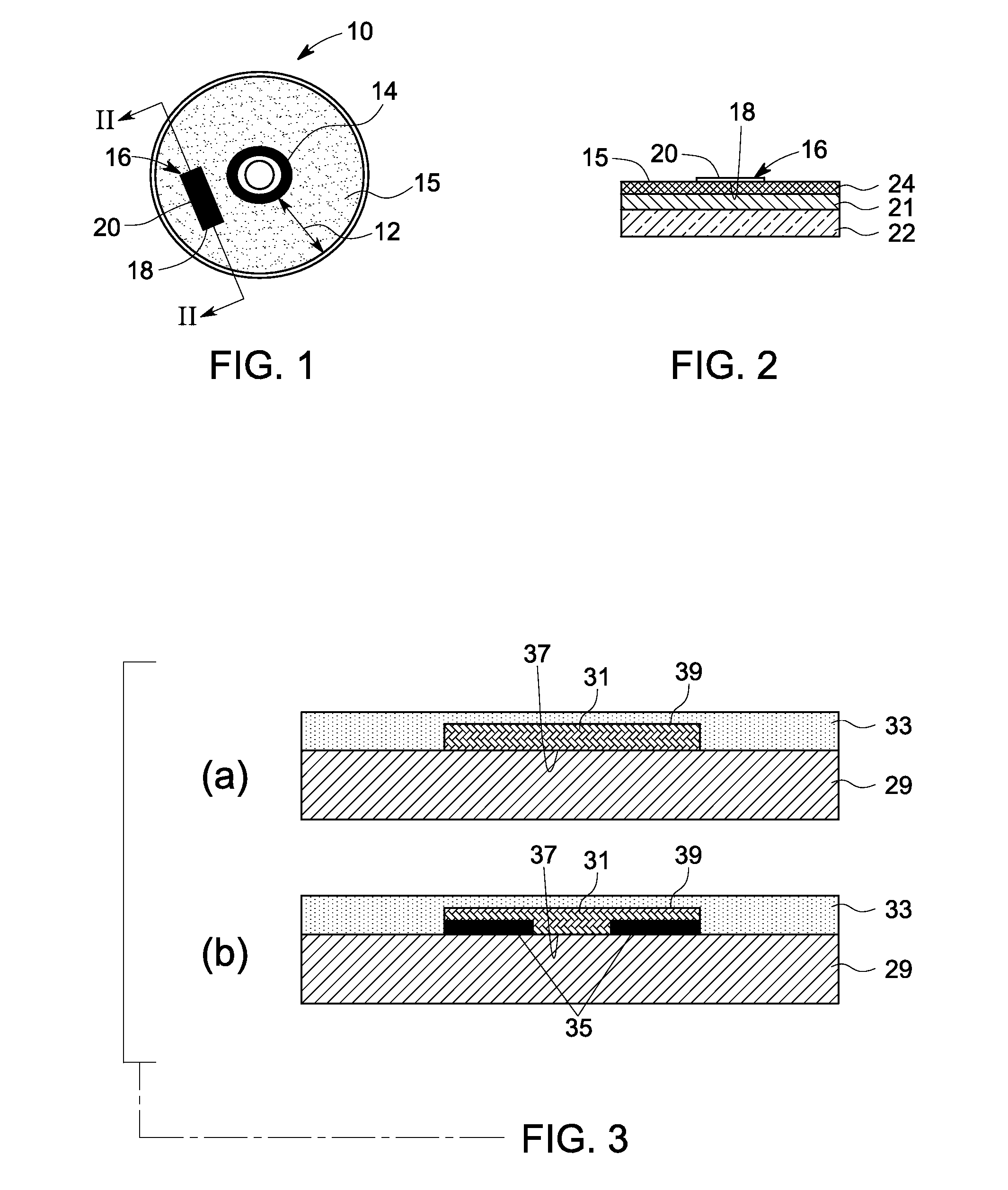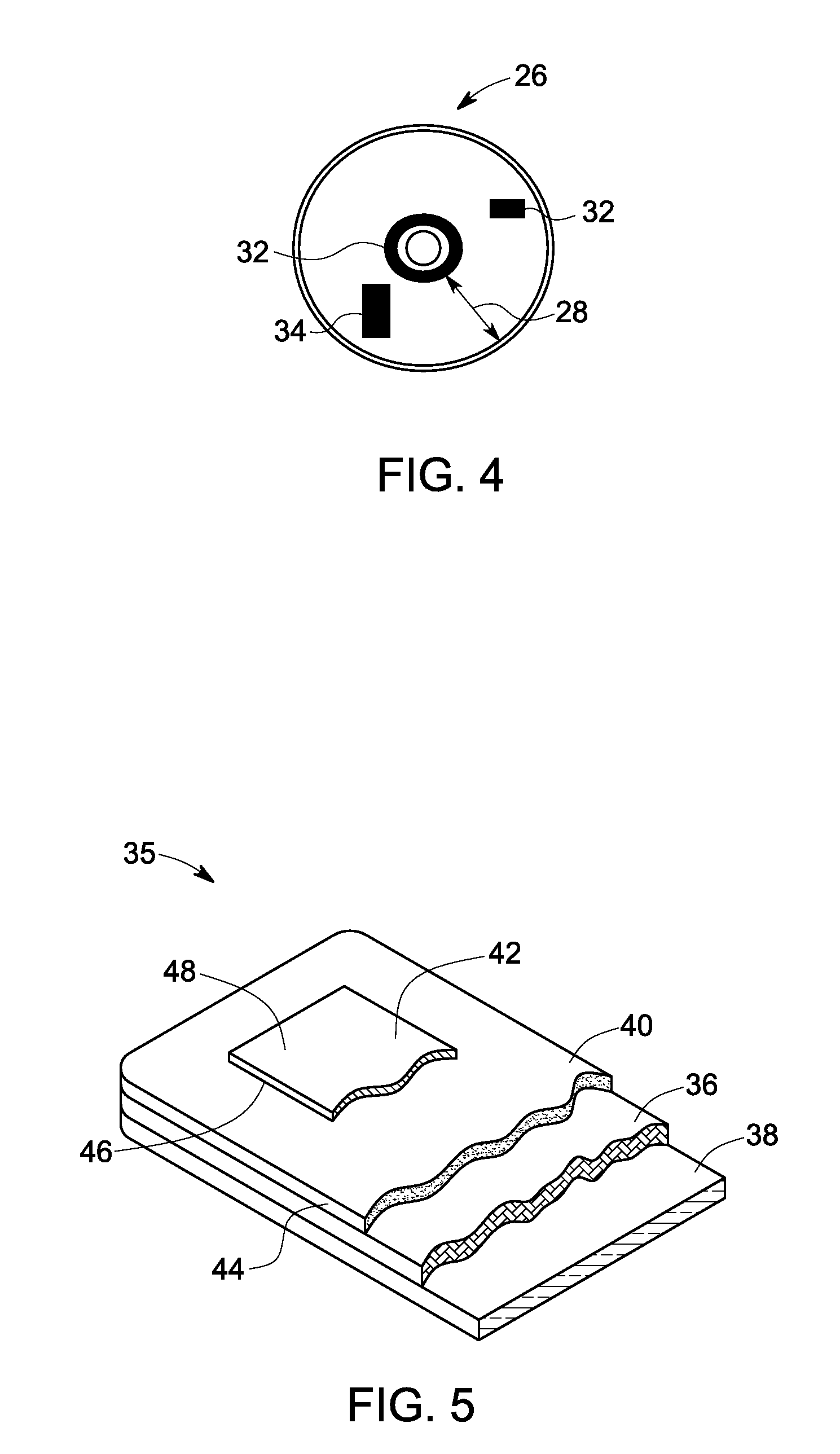Optical article having an electrically responsive layer as an Anti-theft feature and a system and method for inhibiting theft
an optical article and anti-theft technology, applied in the field of optical articles, can solve the problems of increasing the difficulty of keeping an eye on each customer, affecting the quality of the optical article,
- Summary
- Abstract
- Description
- Claims
- Application Information
AI Technical Summary
Problems solved by technology
Method used
Image
Examples
examples
Example: 1 Provides Electrically Responsive Ink Compositions and a Method for Preparing the Same
[0112] Stock Solution 1: Lithium perchlorate (LiClO4, Alrich, CAS 7791-03-9) was dissolved in a mixture of polyethylene glycol (600) diacrylate (SR610, Sartomer), trimethylolpropane triacrylate (SR351, Sartomer), polyethylene glycol 400 (PEG-400, Fluka, CAS 25322-68-3) and propylene carbonate (PC, Aldrich, CAS 108-32-7) by stirring at room temperature for 24 hours (see Table 1 for quantities). To the mixture was added bromocresol green (BCG, Aldrich, 76-60-8) resulting in an orange solution. A small amount of JEFFAMINE ED-900 Polyetheramine (XTJ-501, Huntsman) was added to the mixture to adjust the pH of the stock till the solution attained a blue color.
[0113] Sample 1A: A 20 milliliter (ml) vial was charged with 7.22 grams (g) of Stock Solution 1 and 0.33 g (1.7 millimoles (mmol)) of biphenol (Aldrich, CAS 92-88-6). The mixture was stirred at room temperature (about 20° C.) for 2 hours...
example 2
Provides a Method for Preparing a Polymer Gel Electrolyte Stock Solution
[0121] Lithium perchlorate (LiClO4, Aldrich, CAS 7791-03-9) was dried by heating under vacuum to remove any water. 2.57 g of the dried LiClO4 and 6 g of poly(methyl methacrylate) (PMMA, Mw 350,000, Aldrich, CAS 9011-14-7) were added to 17.14 g anhydrous propylene carbonate (PC, Aldrich, 108-32-7) and 60 g of anhydrous acetonitrile (MeCN) that was dried over calcium hydride and distilled. The mixture was stirred under a nitrogen atmosphere at room temperature (about 20° C.) for 16 hours at which point all solids were dissolved. The resultant polymer gel electrolyte stock solution obtained had the following composition: MeCN / PC / PMMA / LiClO4 (70 / 20 / 7 / 3 weight percent based on the weight of the ink composition).
example 3
Provides an Electrically Responsive Ink Composition Prepared Using the Polymer Gel Electrolyte Stock Solution Prepared in Example 2 and a Method for Preparing the Same
[0122] A 1.5 weight percent mixture of 2,3-dihydrothieno[3,4-b]-1,4-dioxin (EDOT) in the polymer gel electrolyte was prepared by adding 0.019 g of EDOT (Aldrich, CAS 126213-50-1) to 1.24 g of the polymer gel electrolyte stock solution and stirred at room temperature. A thin film of this mixture was prepared between two indium-tin-oxide (ITO) coated glass slides (Delta Technologies Inc.) by the following method. One drop of this mixture was placed on one ITO slide and allowed to dry in an ambient atmosphere for 5 minutes. A second ITO slide was placed on top of the polymer gel electrolyte creating a transparent thin film (about 50 micrometer thick) between the two ITO plates and allowed to dry overnight at room temperature. The thin film was then electrolyzed by applying 3 V DC for 10 seconds and the percent reflectivit...
PUM
| Property | Measurement | Unit |
|---|---|---|
| ion-conductivity | aaaaa | aaaaa |
| conductivity | aaaaa | aaaaa |
| voltage | aaaaa | aaaaa |
Abstract
Description
Claims
Application Information
 Login to view more
Login to view more - R&D Engineer
- R&D Manager
- IP Professional
- Industry Leading Data Capabilities
- Powerful AI technology
- Patent DNA Extraction
Browse by: Latest US Patents, China's latest patents, Technical Efficacy Thesaurus, Application Domain, Technology Topic.
© 2024 PatSnap. All rights reserved.Legal|Privacy policy|Modern Slavery Act Transparency Statement|Sitemap



